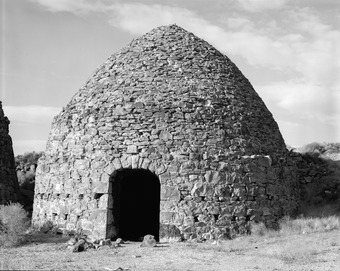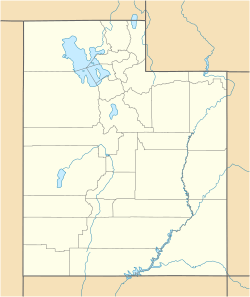Frisco Charcoal Kilns facts for kids
Quick facts for kids |
|
|
Frisco Charcoal Kilns
|
|

Frisco Charcoal Kilns, Kiln No. 2
|
|
| Location | 90 E. Center St., Beaver, Utah |
|---|---|
| Built | 1877–1880 |
| NRHP reference No. | 82004793 |
| Added to NRHP | March 9, 1982 |
The Frisco Charcoal Kilns are old stone structures in the ghost town of Frisco, Utah. They were once very important for getting silver out of the ground. These kilns help us remember Utah's exciting mining past.
Contents
Frisco's Mining Story
The San Francisco Mining District was started on August 12, 1871. This area is in the San Francisco Mountains in Beaver County, Utah. At first, miners mostly looked for a mineral called galena. Galena is a shiny, gray mineral that contains lead and silver.
The Horn Silver Mine
The Horn Silver Mine opened in 1875. This mine quickly became very important for finding silver. The town of Frisco grew up right around this busy mine. Frisco became the center of all the mining activity.
On February 12, 1885, a large part of the Horn Silver Mine collapsed. Luckily, no one was hurt in the accident. The mine kept producing silver for many years. However, some workers started to leave Frisco for other mining areas.
What Are Charcoal Kilns?
Charcoal kilns were used for a process called smelting. Smelting is how you get metal out of ore, which is rock that contains valuable minerals. To do this, you need a lot of heat. Charcoal was used as fuel to create this heat.
Building the Frisco Kilns
In the Frisco area, people had been using charcoal to smelt metals since at least 1872. There were once 36 beehive-shaped kilns in the mining district. Five of these kilns are still standing today in Frisco.
The Frisco Mining and Smelting Company built these five kilns. They were made from strong granite. Construction happened between 1877 and 1880. Each kiln cost between $500 and $1000 to build. They were mainly used to help the Horn Silver Mine.
Kiln Details and History
Each kiln is a different size. They range from 16 to 32 feet wide. The company that built them faced problems after the Horn Silver Mine collapse. They eventually closed down in 1884.
The remaining kilns are a key part of Utah's history. Because of their importance, they were added to the National Register of Historic Places on March 9, 1982. They stand as a reminder of the hard work and history of mining in Utah.



